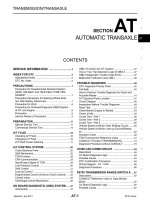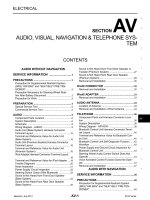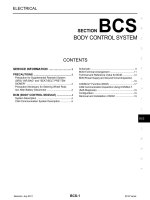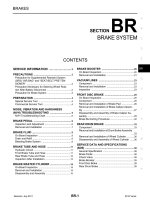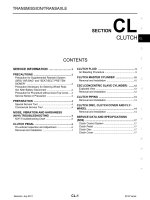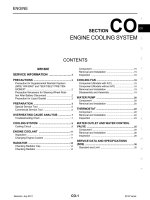EI nội THẤT, NGOẠI THẤT NISSAN VERSA HATCH BACK 2012
Bạn đang xem bản rút gọn của tài liệu. Xem và tải ngay bản đầy đủ của tài liệu tại đây (2.63 MB, 46 trang )
EI-1
BODY
C
D
E
F
G
H
J
K
L
M
SECTION EI
A
B
EI
N
O
P
CONTENTS
EXTERIOR & INTERIOR
PRECAUTION 2
PRECAUTIONS 2
Precaution for Supplemental Restraint System
(SRS) "AIR BAG" and "SEAT BELT PRE-TEN-
SIONER"
2
Precaution Necessary for Steering Wheel Rota-
tion After Battery Disconnect
2
Precaution for Work 3
PREPARATION 4
PREPARATION 4
Special Service Tool 4
Commercial Service Tool 4
CLIP LIST 5
Descriptions for Clips 5
SYMPTOM DIAGNOSIS 9
SQUEAK AND RATTLE TROUBLE DIAGNO-
SIS
9
Work Flow 9
Generic Squeak and Rattle Troubleshooting 11
Diagnostic Worksheet 13
ON-VEHICLE REPAIR 15
FRONT BUMPER 15
Removal and Installation 15
REAR BUMPER 18
Component 18
Removal and Installation 18
FRONT GRILLE 21
Removal and Installation 21
COWL TOP 22
Removal and Installation 22
FENDER PROTECTOR 24
Component 24
Removal and Installation 24
ROOF SIDE MOLDING 25
Component 25
Removal and Installation 25
DOOR OUTSIDE MOLDING 26
Component 26
Removal and Installation 26
CENTER MUD GUARD 28
Removal and Installation 28
REAR AIR SPOILER 29
Removal and Installation 29
DOOR FINISHER 30
Removal and Installation 30
BACK DOOR TRIM 34
Removal and Installation 34
BODY SIDE TRIM 35
Component 35
Removal and Installation 35
FLOOR TRIM 39
Removal and Installation 39
HEADLINING 41
Component 41
Removal and Installation 42
LUGGAGE FLOOR TRIM 44
Removal and Installation 44
Revision: July 2011 2012 Versa
EI-2
< PRECAUTION >
PRECAUTIONS
PRECAUTION
PRECAUTIONS
Precaution for Supplemental Restraint System (SRS) "AIR BAG" and "SEAT BELT
PRE-TENSIONER"
INFOID:0000000007332089
The Supplemental Restraint System such as “AIR BAG” and “SEAT BELT PRE-TENSIONER”, used along
with a front seat belt, helps to reduce the risk or severity of injury to the driver and front passenger for certain
types of collision. This system includes seat belt switch inputs and dual stage front air bag modules. The SRS
system uses the seat belt switches to determine the front air bag deployment, and may only deploy one front
air bag, depending on the severity of a collision and whether the front occupants are belted or unbelted.
Information necessary to service the system safely is included in the SRS and SB section of this Service Man-
ual.
WARNING:
• To avoid rendering the SRS inoperative, which could increase the risk of personal injury or death in
the event of a collision which would result in air bag inflation, all maintenance must be performed by
an authorized NISSAN/INFINITI dealer.
• Improper maintenance, including incorrect removal and installation of the SRS, can lead to personal
injury caused by unintentional activation of the system. For removal of Spiral Cable and Air Bag
Module, see the SRS section.
• Do not use electrical test equipment on any circuit related to the SRS unless instructed to in this
Service Manual. SRS wiring harnesses can be identified by yellow and/or orange harnesses or har-
ness connectors.
PRECAUTIONS WHEN USING POWER TOOLS (AIR OR ELECTRIC) AND HAMMERS
WARNING:
• When working near the Airbag Diagnosis Sensor Unit or other Airbag System sensors with the Igni-
tion ON or engine running, DO NOT use air or electric power tools or strike near the sensor(s) with a
hammer. Heavy vibration could activate the sensor(s) and deploy the air bag(s), possibly causing
serious injury.
• When using air or electric power tools or hammers, always switch the Ignition OFF, disconnect the
battery, and wait at least 3 minutes before performing any service.
Precaution Necessary for Steering Wheel Rotation After Battery Disconnect
INFOID:0000000007332090
NOTE:
• This Procedure is applied only to models with Intelligent Key system and NATS (NISSAN ANTI-THEFT SYS-
TEM).
• Remove and install all control units after disconnecting both battery cables with the ignition knob in the
″LOCK″ position.
• Always use CONSULT to perform self-diagnosis as a part of each function inspection after finishing work. If
DTC is detected, perform trouble diagnosis according to self-diagnostic results.
For models equipped with the Intelligent Key system and NATS, an electrically controlled steering lock mech-
anism is adopted on the key cylinder.
For this reason, if the battery is disconnected or if the battery is discharged, the steering wheel will lock and
steering wheel rotation will become impossible.
If steering wheel rotation is required when battery power is interrupted, follow the procedure below before
starting the repair operation.
OPERATION PROCEDURE
1. Connect both battery cables.
NOTE:
Supply power using jumper cables if battery is discharged.
2. Use the Intelligent Key or mechanical key to turn the ignition switch to the ″ACC″ position. At this time, the
steering lock will be released.
3. Disconnect both battery cables. The steering lock will remain released and the steering wheel can be
rotated.
4. Perform the necessary repair operation.
Revision: July 2011 2012 Versa
PRECAUTIONS
EI-3
< PRECAUTION >
C
D
E
F
G
H
J
K
L
M
A
B
EI
N
O
P
5. When the repair work is completed, return the ignition switch to the ″LOCK″ position before connecting
the battery cables. (At this time, the steering lock mechanism will engage.)
6. Perform a self-diagnosis check of all control units using CONSULT.
Precaution for Work INFOID:0000000007768850
• When removing or disassembling each component, be careful not to damage or deform it. If a component
may be subject to interference, be sure to protect it with a shop cloth.
• When removing (disengaging) components with a screwdriver or similar tool, be sure to wrap the component
with a shop cloth or vinyl tape to protect it.
• Protect the removed parts with a shop cloth and prevent them from being dropped.
• Replace a deformed or damaged clip.
• If a part is specified as a non-reusable part, always replace it with new one.
• Be sure to tighten bolts and nuts securely to the specified torque.
• After installation is complete, be sure to check that each part works properly.
• Follow the steps below to clean components.
- Water soluble dirt: Dip a soft cloth into lukewarm water, and wring the water out of the cloth to wipe the dirty
area.
Then rub with a soft and dry cloth.
- Oily dirt: Dip a soft cloth into lukewarm water with mild detergent (concentration: within 2 to 3%), and wipe
the dirty area.
Then dip a cloth into fresh water, and wring the water out of the cloth to wipe the detergent off. Then rub with
a soft and dry cloth.
• Do not use organic solvent such as thinner, benzene, alcohol, or gasoline.
• For genuine leather seats, use a genuine leather seat cleaner.
Revision: July 2011 2012 Versa
EI-4
< PREPARATION >
PREPARATION
PREPARATION
PREPARATION
Special Service Tool INFOID:0000000007332092
The actual shapes of Kent-Moore tools may differ from those of special service tools illustrated here.
Commercial Service Tool INFOID:0000000007332093
Tool number
(Kent-Moore No.)
Tool name
Description
—
(J-39570)
Chassis ear
Locating the noise
—
(J-43980)
NISSAN Squeak and Rattle kit
Repairing the cause of noise
—
(J-46534)
Trim Tool Set
Removing trim components
SBT839
SBT840
AWJIA0483ZZ
Tool number
(Kent-Moore No.)
Tool name
Description
—
(J-39565)
Engine ear
Locating the noise
SIIA0995E
Revision: July 2011 2012 Versa
CLIP LIST
EI-5
< PREPARATION >
C
D
E
F
G
H
J
K
L
M
A
B
EI
N
O
P
CLIP LIST
Descriptions for Clips INFOID:0000000007768854
Replace any clips which are damaged during removal or installation.
SIIA0315E
Revision: July 2011 2012 Versa
EI-6
< PREPARATION >
CLIP LIST
SIIA0316E
Revision: July 2011 2012 Versa
CLIP LIST
EI-7
< PREPARATION >
C
D
E
F
G
H
J
K
L
M
A
B
EI
N
O
P
SIIA0317E
Revision: July 2011 2012 Versa
EI-8
< PREPARATION >
CLIP LIST
ALJIA0564GB
Revision: July 2011 2012 Versa
SQUEAK AND RATTLE TROUBLE DIAGNOSIS
EI-9
< SYMPTOM DIAGNOSIS >
C
D
E
F
G
H
J
K
L
M
A
B
EI
N
O
P
SYMPTOM DIAGNOSIS
SQUEAK AND RATTLE TROUBLE DIAGNOSIS
Work Flow INFOID:0000000007768851
CUSTOMER INTERVIEW
Interview the customer if possible, to determine the conditions that exist when the noise occurs. Use the Diag-
nostic Worksheet during the interview to document the facts and conditions when the noise occurs and any
customer's comments; refer to EI-13, "
Diagnostic Worksheet". This information is necessary to duplicate the
conditions that exist when the noise occurs.
• The customer may not be able to provide a detailed description or the location of the noise. Attempt to obtain
all the facts and conditions that exist when the noise occurs (or does not occur).
• If there is more than one noise in the vehicle, be sure to diagnose and repair the noise that the customer is
concerned about. This can be accomplished by test driving the vehicle with the customer.
• After identifying the type of noise, isolate the noise in terms of its characteristics. The noise characteristics
are provided so the customer, service adviser and technician are all speaking the same language when
defining the noise.
• Squeak —(Like tennis shoes on a clean floor)
Squeak characteristics include the light contact/fast movement/brought on by road conditions/hard surfaces
= higher pitch noise/softer surfaces = lower pitch noises/edge to surface = chirping.
• Creak—(Like walking on an old wooden floor)
Creak characteristics include firm contact/slow movement/twisting with a rotational movement/pitch depen-
dent on materials/often brought on by activity.
• Rattle—(Like shaking a baby rattle)
Rattle characteristics include the fast repeated contact/vibration or similar movement/loose parts/missing
clip or fastener/incorrect clearance.
• Knock —(Like a knock on a door)
Knock characteristics include hollow sounding/sometimes repeating/often brought on by driver action.
• Tick—(Like a clock second hand)
Tick characteristics include gentle contacting of light materials/loose components/can be caused by driver
action or road conditions.
• Thump—(Heavy, muffled knock noise)
Thump characteristics include softer knock/dead sound often brought on by activity.
• Buzz—(Like a bumble bee)
Buzz characteristics include high frequency rattle/firm contact.
• Often the degree of acceptable noise level will vary depending upon the person. A noise that you may judge
as acceptable may be very irritating to the customer.
• Weather conditions, especially humidity and temperature, may have a great effect on noise level.
DUPLICATE THE NOISE AND TEST DRIVE
SBT842
Revision: July 2011 2012 Versa
EI-10
< SYMPTOM DIAGNOSIS >
SQUEAK AND RATTLE TROUBLE DIAGNOSIS
If possible, drive the vehicle with the customer until the noise is duplicated. Note any additional information on
the Diagnostic Worksheet regarding the conditions or location of the noise. This information can be used to
duplicate the same conditions when you confirm the repair.
If the noise can be duplicated easily during the test drive, to help identify the source of the noise, try to dupli-
cate the noise with the vehicle stopped by doing one or all of the following:
1) Close a door.
2) Tap or push/pull around the area where the noise appears to be coming from.
3) Rev the engine.
4) Use a floor jack to recreate vehicle “twist”.
5) At idle, apply engine load (electrical load, half-clutch on M/T model, drive position on CVT and A/T models).
6) Raise the vehicle on a hoist and hit a tire with a rubber hammer.
• Drive the vehicle and attempt to duplicate the conditions the customer states exist when the noise occurs.
• If it is difficult to duplicate the noise, drive the vehicle slowly on an undulating or rough road to stress the
vehicle body.
CHECK RELATED SERVICE BULLETINS
After verifying the customer concern or symptom, check ASIST for Technical Service Bulletins (TSBs) related
to that concern or symptom.
If a TSB relates to the symptom, follow the procedure to repair the noise.
LOCATE THE NOISE AND IDENTIFY THE ROOT CAUSE
1. Narrow down the noise to a general area. To help pinpoint the source of the noise, use a listening tool
(Chassis Ear: J-39570, Engine Ear: J-39565 and mechanic's stethoscope).
2. Narrow down the noise to a more specific area and identify the cause of the noise by:
• removing the components in the area that you suspect the noise is coming from.
Do not use too much force when removing clips and fasteners, otherwise clips and fasteners can be
broken or lost during the repair, resulting in the creation of new noise.
• tapping or pushing/pulling the component that you suspect is causing the noise.
Do not tap or push/pull the component with excessive force, otherwise the noise will be eliminated only
temporarily.
• feeling for a vibration with your hand by touching the component(s) that you suspect is (are) causing the
noise.
• placing a piece of paper between components that you suspect are causing the noise.
• looking for loose components and contact marks.
Refer to EI-11, "
Generic Squeak and Rattle Troubleshooting".
REPAIR THE CAUSE
• If the cause is a loose component, tighten the component securely.
• If the cause is insufficient clearance between components:
- separate components by repositioning or loosening and retightening the component, if possible.
- insulate components with a suitable insulator such as urethane pads, foam blocks, felt cloth tape or urethane
tape. A NISSAN Squeak and Rattle Kit (J-43980) is available through your authorized NISSAN Parts Depart-
ment.
CAUTION:
Do not use excessive force as many components are constructed of plastic and may be damaged.
Always check with the Parts Department for the latest parts information.
The following materials are contained in the NISSAN Squeak and Rattle Kit (J-43980). Each item can be
ordered separately as needed.
URETHANE PADS [1.5 mm (0.059 in) thick]
Insulates connectors, harness, etc.
76268-9E005: 100×135 mm (3.94×5.31 in)/76884-71L01: 60×85 mm (2.36×3.35 in)/76884-71L02: 15×25
mm (0.59×0.98 in)
INSULATOR (Foam blocks)
Insulates components from contact. Can be used to fill space behind a panel.
73982-9E000: 45 mm (1.77 in) thick, 50×50 mm (1.97×1.97 in)/73982-50Y00: 10 mm (0.39 in) thick,
50×50 mm (1.97×1.97 in)
INSULATOR (Light foam block)
80845-71L00: 30 mm (1.18 in) thick, 30×50 mm (1.18×1.97 in)
FELT CLOTH TAPE
Used to insulate where movement does not occur. Ideal for instrument panel applications.
68370-4B000: 15×25 mm (0.59×0.98 in) pad/68239-13E00: 5 mm (0.20 in) wide tape roll. The following
materials not found in the kit can also be used to repair squeaks and rattles.
Revision: July 2011 2012 Versa
SQUEAK AND RATTLE TROUBLE DIAGNOSIS
EI-11
< SYMPTOM DIAGNOSIS >
C
D
E
F
G
H
J
K
L
M
A
B
EI
N
O
P
UHMW (TEFLON) TAPE
Insulates where slight movement is present. Ideal for instrument panel applications.
SILICONE GREASE
Used instead of UHMW tape that will be visible or not fit.
Note: Will only last a few months.
SILICONE SPRAY
Use when grease cannot be applied.
DUCT TAPE
Use to eliminate movement.
CONFIRM THE REPAIR
Confirm that the cause of a noise is repaired by test driving the vehicle. Operate the vehicle under the same
conditions as when the noise originally occurred. Refer to the notes on the Diagnostic Worksheet.
Generic Squeak and Rattle Troubleshooting INFOID:0000000007768852
Refer to Table of Contents for specific component removal and installation information.
INSTRUMENT PANEL
Most incidents are caused by contact and movement between:
1. The cluster lid A and instrument panel
2. Acrylic lens and combination meter housing
3. Instrument panel to front pillar garnish
4. Instrument panel to windshield
5. Instrument panel pins
6. Wiring harnesses behind the combination meter
7. A/C defroster duct and duct joint
These incidents can usually be located by tapping or moving the components to duplicate the noise or by
pressing on the components while driving to stop the noise. Most of these incidents can be repaired by apply-
ing felt cloth tape or silicone spray (in hard to reach areas). Urethane pads can be used to insulate wiring har-
ness.
CAUTION:
Do not use silicone spray to isolate a squeak or rattle. If you saturate the area with silicone, you will
not be able to recheck the repair.
CENTER CONSOLE
Components to pay attention to include:
1. Shift selector assembly cover to finisher
2. A/C control unit and cluster lid C
3. Wiring harnesses behind audio and A/C control unit
The instrument panel repair and isolation procedures also apply to the center console.
DOORS
Pay attention to the:
1. Finisher and inner panel making a slapping noise
2. Inside handle escutcheon to door finisher
3. Wiring harnesses tapping
4. Door striker out of alignment causing a popping noise on starts and stops
Tapping or moving the components or pressing on them while driving to duplicate the conditions can isolate
many of these incidents. You can usually insulate the areas with felt cloth tape or insulator foam blocks from
the NISSAN Squeak and Rattle Kit (J-43980) to repair the noise.
TRUNK
Trunk noises are often caused by a loose jack or loose items put into the trunk by the owner.
In addition look for:
1. Trunk lid bumpers out of adjustment
2. Trunk lid striker out of adjustment
3. The trunk lid torsion bars knocking together
Revision: July 2011 2012 Versa
EI-12
< SYMPTOM DIAGNOSIS >
SQUEAK AND RATTLE TROUBLE DIAGNOSIS
4. A loose license plate or bracket
Most of these incidents can be repaired by adjusting, securing or insulating the item(s) or component(s) caus-
ing the noise.
SUNROOF/HEADLINING
Noises in the sunroof/headlining area can often be traced to one of the following:
1. Sunroof lid, rail, linkage or seals making a rattle or light knocking noise
2. Sun visor shaft shaking in the holder
3. Front or rear windshield touching headliner and squeaking
Again, pressing on the components to stop the noise while duplicating the conditions can isolate most of these
incidents. Repairs usually consist of insulating with felt cloth tape.
OVERHEAD CONSOLE (FRONT AND REAR)
Overhead console noises are often caused by the console panel clips not being engaged correctly. Most of
these incidents are repaired by pushing up on the console at the clip locations until the clips engage.
In addition look for:
1. Loose harness or harness connectors.
2. Front console map/reading lamp lens loose.
3. Loose screws at console attachment points.
SEATS
When isolating seat noise it's important to note the position the seat is in and the load placed on the seat when
the noise is present. These conditions should be duplicated when verifying and isolating the cause of the
noise.
Cause of seat noise include:
1. Headrest rods and holder
2. A squeak between the seat pad cushion and frame
3. The rear seatback lock and bracket
These noises can be isolated by moving or pressing on the suspected components while duplicating the con-
ditions under which the noise occurs. Most of these incidents can be repaired by repositioning the component
or applying urethane tape to the contact area.
UNDERHOOD
Some interior noise may be caused by components under the hood or on the engine wall. The noise is then
transmitted into the passenger compartment.
Causes of transmitted underhood noise include:
1. Any component installed to the engine wall
2. Components that pass through the engine wall
3. Engine wall mounts and connectors
4. Loose radiator installation pins
5. Hood bumpers out of adjustment
6. Hood striker out of adjustment
These noises can be difficult to isolate since they cannot be reached from the interior of the vehicle. The best
method is to secure, move or insulate one component at a time and test drive the vehicle. Also, engine rpm or
load can be changed to isolate the noise. Repairs can usually be made by moving, adjusting, securing, or
insulating the component causing the noise.
Revision: July 2011 2012 Versa
SQUEAK AND RATTLE TROUBLE DIAGNOSIS
EI-13
< SYMPTOM DIAGNOSIS >
C
D
E
F
G
H
J
K
L
M
A
B
EI
N
O
P
Diagnostic Worksheet INFOID:0000000007768853
LAIA0072E
Revision: July 2011 2012 Versa
EI-14
< SYMPTOM DIAGNOSIS >
SQUEAK AND RATTLE TROUBLE DIAGNOSIS
LAIA0071E
Revision: July 2011 2012 Versa
FRONT BUMPER
EI-15
< ON-VEHICLE REPAIR >
C
D
E
F
G
H
J
K
L
M
A
B
EI
N
O
P
ON-VEHICLE REPAIR
FRONT BUMPER
Removal and Installation INFOID:0000000007332098
1. Bumper stay RH 2. Bumper reinforcement (production) 3. Bumper energy absorber
4. Front valance 5. Front bumper fascia 6. Tow cover
7. Fog lamp opening finisher (without
fog lamps)
8. Fog lamp opening finisher (with fog
lamps)
9. Fog lamp assembly
10. Bumper side retainer 11. Bumper stay LH (service) A. Clip C205
AWKIA1909ZZ
Revision: July 2011 2012 Versa
EI-16
< ON-VEHICLE REPAIR >
FRONT BUMPER
CAUTION:
Bumper fascia is made of resin. Do not apply strong force to it, and be careful to prevent contact with
oil.
REMOVAL
1. Open hood.
2. Remove front grille. Refer to EI-21
.
3. Remove front fender protectors RH/LH. Refer to EI-24
.
4. Remove front valance.
5. Remove screws of front bumper fascia RH/LH.
6. Pull the outboard edge of front bumper fascia away from vehicle
to disengage from the bumper side retainer.
7. Disconnect fog lamp harness connector RH/LH (if equipped).
8. Remove the front bumper fascia.
9. Remove fog lamp opening finisher and fog lamp assembly RH/
LH (if equipped). Refer to LT-49, "
Removal and Installation".
10. Remove bumper energy absorber.
11. Remove RH/LH air guide mounting clips of bumper reinforcement.
12. Remove the nuts, then remove bumper reinforcement and bumper stay(s):
• For production, bumper stay LH is part of bumper reinforcement.
• For service, bumper stay RH/LH are separate assemblies.
13. Remove bumper side bracket RH/LH after front bumper fascia removal.
INSTALLATION
PIIB2537J
PIIB2538J
PIIB2543J
Revision: July 2011 2012 Versa
FRONT BUMPER
EI-17
< ON-VEHICLE REPAIR >
C
D
E
F
G
H
J
K
L
M
A
B
EI
N
O
P
Installation is in the reverse order of removal.
mm (in)
ALKIA1929ZZ
Component Portion Minimum Target Value Maximum
Front bumper - Hood Clearance A-A 4.0 (0.157) 6.0 (0.236) 8.5 (0.335)
Front bumper - Hood Surface A-A -1.9 (0.075) 0.65 (0.026) 2.65 (0.104)
Front bumper - Front grille B-B 1.0 (0.039) 2.0 (0.079) 3.0 (0.118)
Front bumper - Head lamp C-C 0.3 (0.012) 2.0 (0.079) 3.7 (0.146)
Front bumper - Front fender Clearance D-D 0.0 (0.000) 0.0 (0.000) 1.0 (0.039)
Front bumper - Front fender Surface D-D -0.35 (0.014) 0.65 (0.026) 1.65 (0.065)
Revision: July 2011 2012 Versa
EI-18
< ON-VEHICLE REPAIR >
REAR BUMPER
REAR BUMPER
Component INFOID:0000000007332099
Removal and Installation INFOID:0000000007332100
REMOVAL
1. Open back door.
2. Remove rear combination lamp RH/LH. Refer to LT-83, "
Removal and Installation".
3. Remove rear bumper fascia spring nuts and screws RH/LH.
4. Remove rear fender protector. Refer to EI-24, "
Removal and Installation".
WIIA1406E
1. Bumper side bracket 2. Rear fender protector 3. Spring nut
4. Bumper reinforcement bracket 5. Rear bumper reinforcement 6. Energy absorbing foam
7. Rear bumper fascia 8. Rear bumper upper retainer A. Clip C205
Revision: July 2011 2012 Versa
REAR BUMPER
EI-19
< ON-VEHICLE REPAIR >
C
D
E
F
G
H
J
K
L
M
A
B
EI
N
O
P
5. Pull the rear bumper fascia side outward and release the
bumper side bracket.
6. Remove rear bumper fascia upper clips and screws.
7. Release rear bumper upper retainer (1), then pull rear bumper
fascia outward away from rear of vehicle.
8. Disconnect license lamp connector.
9. Remove energy absorbing foam and rear bumper reinforcement.
10. Remove the bumper side bracket (1) RH/LH.
• : Vehicle front
INSTALLATION
Installation is in the reverse order of removal.
mm (in)
LIIA2579E
LIIA2580E
LIIA2581E
ALKIA1930ZZ
Revision: July 2011 2012 Versa
EI-20
< ON-VEHICLE REPAIR >
REAR BUMPER
Component Portion Minimum Target Value Maximum
Rear bumper - Back door clearance A-A 4.0 (0.157) 6.0 (0.236) 8.0 (0.315)
Rear bumper - Rear combination lamp
clearance
B-B 1.0 (0.039) 2.0 (0.079) 3.5 (0.138)
Rear bumper - Rear combination lamp
surface
B-B -1.7 (-0.067) 0.0 (0.000) 1.7 (0.067)
Rear bumper - Rear fender clearance
C-C
D-D
0.0 (0.000) 0.0 (0.000) 1.0 (0.039)
Rear bumper - Rear fender surface C-C -1.7 (-0.067) -0.7 (-0.028) 0.3 (0.012)
Rear bumper - Rear fender surface D-D -0.3 (-0.012) 0.7 (0.028) 1.7 (0.067)
Revision: July 2011 2012 Versa
FRONT GRILLE
EI-21
< ON-VEHICLE REPAIR >
C
D
E
F
G
H
J
K
L
M
A
B
EI
N
O
P
FRONT GRILLE
Removal and Installation INFOID:0000000007332102
REMOVAL
1. Open hood assembly.
2. Remove the clips, then remove upper radiator cover.
3. Remove the upper clips and release the lower pawls, then pull outward to remove the front grille.
INSTALLATION
Installation is in the reverse order of removal.
LIIA2564E
1. Upper radiator cover 2. Front grille 3. Front bumper fascia
4. Clip C205 Pawl
Revision: July 2011 2012 Versa
EI-22
< ON-VEHICLE REPAIR >
COWL TOP
COWL TOP
Removal and Installation INFOID:0000000007332103
REMOVAL
1. Remove front wiper arm RH/LH from vehicle. Refer to WW-20, "Removal and Installation of Front Wiper
Arms".
2. Disconnect washer tube.
3. Remove fender seal and fender cover RH/LH.
4. Release the cowl top seal clips, then remove cowl top seal.
LIIA2565E
1. Fender cover 2. Fender seal 3. Washer tube
4. Cowl top seal 5. Cowl extension panel 6. Dual lock fastener
7. Double-faced adhesive tape 8. Cowl top cover 9. Clip C205
10. EPT sealer 11. Cowl extension clip 12. Cover
Clip CE103 Vehicle front
PIIB2555J
Revision: July 2011 2012 Versa
COWL TOP
EI-23
< ON-VEHICLE REPAIR >
C
D
E
F
G
H
J
K
L
M
A
B
EI
N
O
P
5. Release the cowl extension clip (1) by prying the center pawls
apart and pulling clip outward. Remove remaining clips, then
remove cowl top cover (2).
6. Disconnect and remove the front wiper motor and linkage
assembly. Refer to WW-22, "
Removal and Installation of Front
Wiper Drive Assembly".
CAUTION:
To avoid damage, make sure to cover the lower edge of
windshield with suitable protection material.
7. Remove cowl extension panel bolts, then remove cowl extension panel.
INSTALLATION
Installation is in the reverse order of removal.
NOTE:
• For wiper arm RH/LH installation and adjustment, Refer to WW-20, "
Removal and Installation of Front Wiper
Arms".
• Always replace EPT sealer and double-faced adhesive tape when installing cowl top cover.
LIIA2566E
PIIB6038E
Revision: July 2011 2012 Versa
EI-24
< ON-VEHICLE REPAIR >
FENDER PROTECTOR
FENDER PROTECTOR
Component INFOID:0000000007332104
Removal and Installation INFOID:0000000007332105
FRONT FENDER PROTECTOR
Removal
1. Remove front fender protector bolts and clips.
2. Remove front fender protector.
Installation
Installation is in the reverse order of removal.
REAR FENDER PROTECTOR
Removal
1. Remove rear fender protector bolt and clip.
2. Remove rear fender protector.
Installation
Installation is in the reverse order of removal.
1. Front fender protector 2. Clip C205 3. Rear fender protector
Clip C103 Vehicle front
LIIA2567E
Revision: July 2011 2012 Versa
ROOF SIDE MOLDING
EI-25
< ON-VEHICLE REPAIR >
C
D
E
F
G
H
J
K
L
M
A
B
EI
N
O
P
ROOF SIDE MOLDING
Component INFOID:0000000007332106
Removal and Installation INFOID:0000000007332107
REMOVAL
1. Using a suitable tool, release the rear roof side molding clip and remove.
2. Lift up rear edge of roof side molding working forward.
3. Release front roof side molding clip, then remove roof side molding.
INSTALLATION
Installation is in the reverse order of removal.
NOTE:
Make sure front edge of roof side molding contacts windshield mold-
ing with no gap.
• For setting a new clip A or B, use Epoxy Adhesive DP-100C made
by 3M. For adhesive DP-100C application use an applicator 9170
EPX W 1:1 and mixer nozzle 9742 EPX 50ML made by 3M.
AWKIA1898ZZ
1. Roof side molding A. Front roof side molding clip B. Rear roof side molding clip
PIIB2599J
Revision: July 2011 2012 Versa

